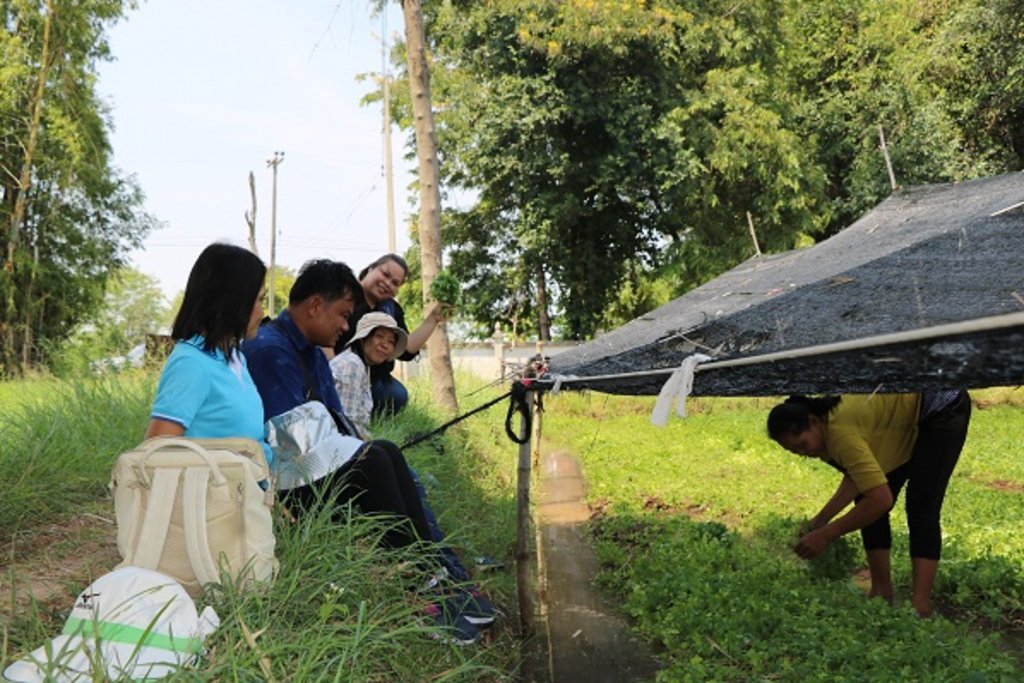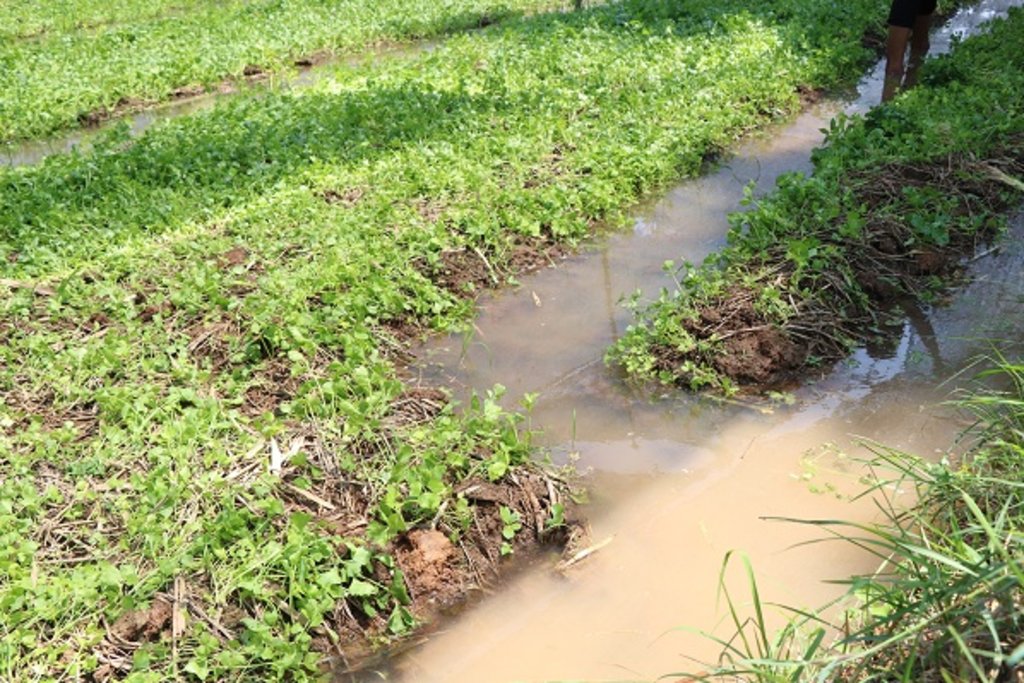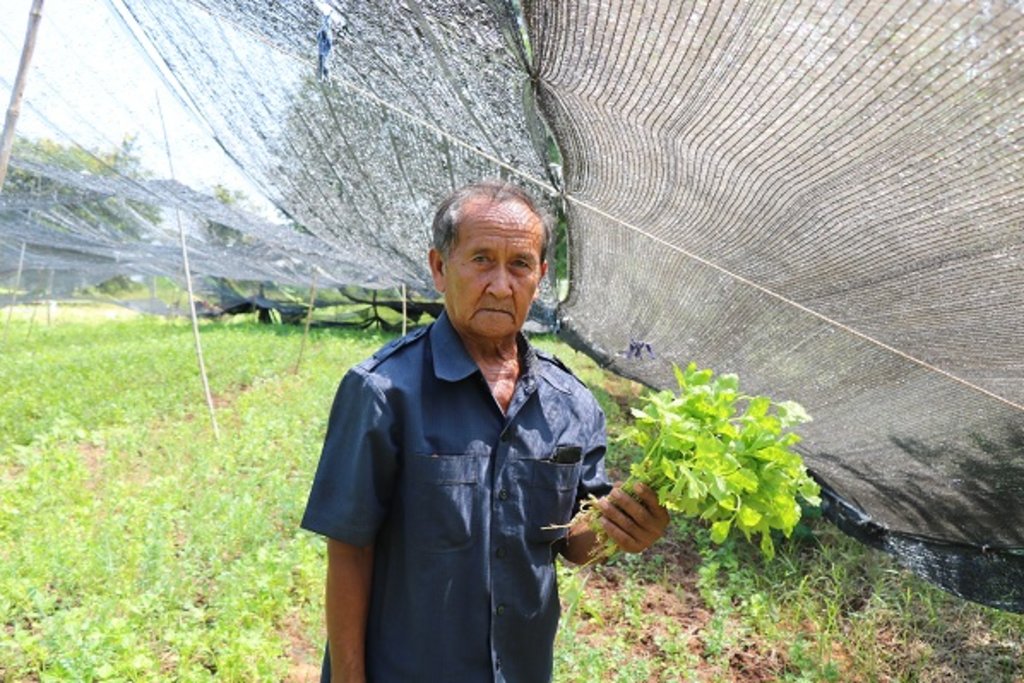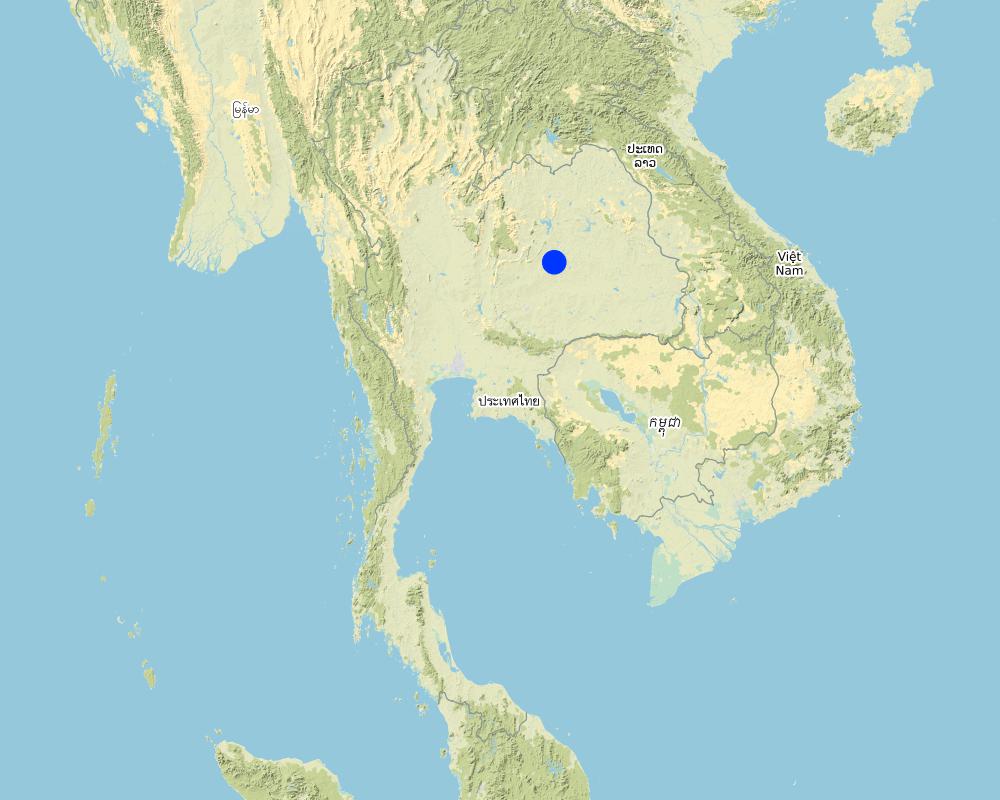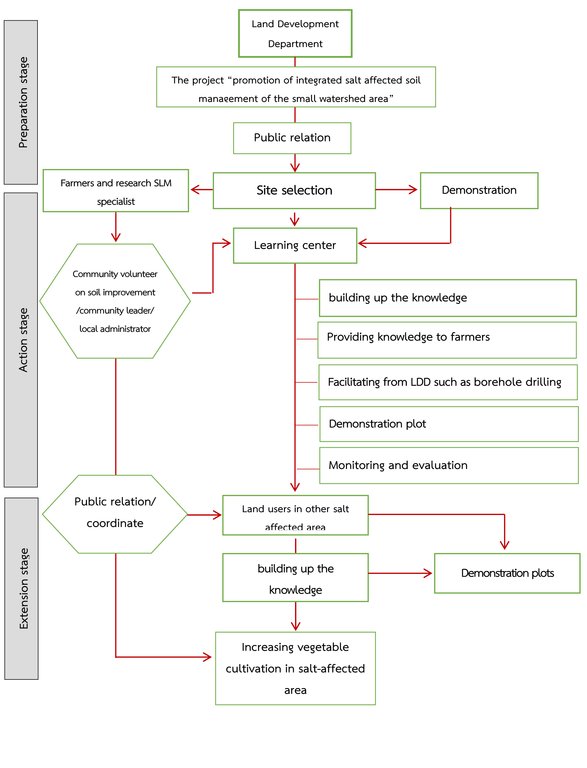Pumping groundwater for vegetable irrigation to prevent salination [ไทย]
- ผู้สร้างสรรค์:
- การอัพเดท:
- ผู้รวบรวม: supranee sritumboon
- ผู้เรียบเรียง: –
- ผู้ตรวจสอบ: Rima Mekdaschi Studer, Pitayakon Limtong, William Critchley
approaches_4298 - ไทย
ดูส่วนย่อย
ขยายทั้งหมด ย่อทั้งหมด1. ข้อมูลทั่วไป
1.2 รายละเอียดที่ติดต่อได้ของผู้รวบรวมและองค์กรที่เกี่ยวข้องในการประเมินและการจัดเตรียมทำเอกสารของแนวทาง
วิทยากรหลัก
Somked Boonmee
ไทย
ผู้เชี่ยวชาญ SLM:
Sihaban Pranee
pranee782@gmail.com
Land Development Department Regional Office 5
ไทย
ผู้เชี่ยวชาญ SLM:
Sritumboon Supranee
ssritumboon@yahoo.com
Land Development Department Regional Office 5
ไทย
ผู้เชี่ยวชาญ SLM:
Jakkarach Usa
usa_kl@hotmail.com
Land Development Department Regional Office 5
ไทย
ผู้เชี่ยวชาญ SLM:
Rophandung Weera
weerop@hotmail.com
Land Development Department Regional Office 5
ไทย
ผู้เชี่ยวชาญ SLM:
Phothinam Pornpana
laosuwan18@hotmail.com
Land Development Department Regional Office 5
ไทย
ผู้เชี่ยวชาญ SLM:
National Consultant:
Arunin Somsri
ssarunin@gmail.com
Land Development Department
ไทย
ชื่อของโครงการซึ่งอำนวยความสะดวกในการทำเอกสารหรือการประเมินแนวทาง (ถ้าเกี่ยวข้อง)
Decision Support for Mainstreaming and Scaling out Sustainable Land Management (GEF-FAO / DS-SLM)ชื่อของโครงการซึ่งอำนวยความสะดวกในการทำเอกสารหรือการประเมินแนวทาง (ถ้าเกี่ยวข้อง)
Book project: where people and their land are safer - A Compendium of Good Practices in Disaster Risk Reduction (DRR) (where people and their land are safer)ชื่อของโครงการซึ่งอำนวยความสะดวกในการทำเอกสารหรือการประเมินแนวทาง (ถ้าเกี่ยวข้อง)
Book project: where the land is greener - Case Studies and Analysis of Soil and Water Conservation Initiatives Worldwide (where the land is greener)ชื่อของโครงการซึ่งอำนวยความสะดวกในการทำเอกสารหรือการประเมินแนวทาง (ถ้าเกี่ยวข้อง)
Land Development Department LDD (Land Development Department LDD) - ไทย1.3 เงื่อนไขที่เกี่ยวข้องกับการใช้ข้อมูลที่ได้บันทึกไว้ผ่านทาง WOCAT
ผู้รวบรวมและวิทยากรหลักยอมรับเงื่อนไขเกี่ยวกับการใช้ข้อมูลที่ถูกบันทึกผ่านทาง WOCAT:
ใช่
2. คำอธิบายของแนวทาง SLM
2.1 การอธิบายแบบสั้น ๆ ของแนวทาง
The approach is to develop a simple groundwater pumping model for irrigation, on the basis of cooperation and knowledge sharing between government agencies and farmers, that addresses the risk and prevention of off-site salination.
2.2 การอธิบายอย่างละเอียดของแนวทาง
การอธิบายอย่างละเอียดของแนวทาง:
The objective of groundwater pumping for irrigation is to lower the groundwater level in the recharge zone which in turn decreases soil salinity lower down in the discharge area. The extension and promotion of the approach has been done through the learning and training center. The goal is better understanding and public awareness of preventive measure against salinity, through the use of salt-tolerant crops, combined with mechanical measures of accessing groundwater for irrigation. This has been achieved in close cooperation among researchers, SLM specialists, local administration, and community volunteers on soil improvement. A group of farmers started this activity in 1996 under the Land Development Department (LDD)’s Project on Promotion of Integrated Salt-Affected Soil Management of Small Watershed Areas. The approach aims at scaling-out the model to farmers in the recharge areas with the objectives of sharing benefits that are to (a) persuade other land users to change their land use from rice which is a high water-use crop to low water-use crops such as vegetables, (b) prevent further off-site salination, (c) increase land users’ income, and (d) provide knowledge about integrated salinity management. Researchers and SLM specialists work closely with farmers in monitoring and evaluating the recharge area to prevent extensive salination in the discharge zone - as well as the use of groundwater for irrigation. This plan has been formulated to stimulate further promotion and extension to other areas with a similar environment, through training and public relations. The four stages were: first, the expert and agriculturalist of the LDD’s Regional Office 5 (LDDRO5) cooperated with the volunteer soil doctor and farmers in the community to design and plan the project; second, the officers of LDDRO5 set up a forum for exchange of knowledge and experiences between farmers who have been successful in producing vegetables through using shallow groundwater for agriculture, and are not affected by a salinity. Thirdly, the officers of LDDRO5 collaborated with the government office in the district to train farmers who had an interest in vegetable production. Fourthly, LDDRO5 created incentives for farmers to change areas that are not suitable for planting paddy rice to grow vegetables by supporting shallow groundwater well through pumping with solar energy. The stakeholders include the LDD, SLM specialists and researchers, local administrators, and community volunteers on soil improvement and land users. Land users like the project activities because they receive higher incomes – partially because they do not lose land to digging ponds, but instead irrigate from these deep wells from which they can irrigate all year round. The LDD has supported borehole drilling wells – but farmers are not so happy when they have to wait for over a year to get LDD’s borehole drilling due to budget limitations.
2.3 รูปภาพของแนวทาง
ข้อสังเกตทั่วไปเกี่ยวกับรูปภาพ:
Vegetable cultivation was developed based on farmer experience.
2.4 วีดีโอของแนวทาง
วันที่:
02/10/2018
สถานที่:
Ban Kaonoi
ชื่อของผู้ถ่ายวีดีโอ:
Supranee Sritumboon
2.5 ประเทศ ภูมิภาค หรือสถานที่ตั้งที่ได้นำแนวทางไปใช้
ประเทศ:
ไทย
ภูมิภาค/รัฐ/จังหวัด: :
Khon Kaen
ข้อมูลเฉพาะเพิ่มเติมของสถานที่ตั้ง:
Ban Kaonoi
Map
×2.6 วันที่เริ่มต้นและสิ้นสุดของแนวทาง
ระบุปีที่เริ่ม:
2007
ถ้าไม่รู้ปีที่แน่นอนให้ประมาณวันที่ที่ริเริ่มใช้แนวทางนี้ :
10-50 ปี
2.7 ประเภทของแนวทาง
- ใช้โครงงานหรือแผนงานเป็นฐาน
2.8 เป้าหมายหรือวัตถุประสงค์หลักของแนวทาง
The objectives of the approach are to persuade land users in the recharge zone to change their land use to low-water use such as vegetable cultivation, to prevent further off-site salination, to increase land users’ income and provide knowledge of integrated salinity management.
2.9 เงื่อนไขที่เอื้ออำนวยหรือเป็นอุปสรรคต่อการนำเทคโนโลยีภายใต้แนวทางนี้ไปปฏิบัติใช้
บรรทัดฐานและค่านิยมทางสังคม วัฒนธรรม ศาสนา
- เอื้ออำนวย
Farmers' community
การมีไว้ให้หรือการเข้าถึงแหล่งการเงินและบริการ
- เอื้ออำนวย
Farmers get higher income from vegetables.
การร่วมมือหรือการทำงานประสานกันของผู้ลงมือปฏิบัติ
- เอื้ออำนวย
Researchers, SLM specialists and farmers are working together to implement the project.
ความรู้เกี่ยวกับ SLM การเข้าถึงการสนับสนุนด้านเทคนิค
- เอื้ออำนวย
Provide knowledge of integrated salinity management to farmers.
ตลาด (จัดซื้อปัจจัยนำเข้า ขายผลิตภัณฑ์) และราคา
- เอื้ออำนวย
Farmers can produce plants according to market demand.
3. การมีส่วนร่วมและบทบาทของผู้มีส่วนได้ส่วนเสียที่เกี่ยวข้อง
3.1 ผู้มีส่วนได้ส่วนเสียที่เกี่ยวข้องในแนวทางนี้และบทบาท
- ผู้ใช้ที่ดินระดับท้องถิ่นหรือชุมชนระดับท้องถิ่น
Farmers
Vegetable cultivation
- ผู้เชี่ยวชาญ SLM หรือที่ปรึกษาการเกษตร
Government officers
Support knowledge and technology
- รัฐบาลระดับท้องถิ่น
Subdistrict Administration Organization
Support information
- community volunteer on soil
Community volunteers on soil and successful farmers
Share knowledge and experience
ถ้ามีผู้มีส่วนได้ส่วนเสียหลายคนที่เกี่ยวข้องให้ระบุหน่วยงานตัวแทน:
Land Development Department Regional Office 5
3.2 การเกี่ยวข้องของผู้ใช้ที่ดินระดับท้องถิ่นหรือชุมชนระดับท้องถิ่นในช่วงต่างๆของแนวทาง
| ความเกี่ยวข้องของผู้ใช้ที่ดินระดับท้องถิ่นหรือชุมชนระดับท้องถิ่น | ระบุผู้ที่มีส่วนเกี่ยวข้องและอธิบายกิจกรรม | |
|---|---|---|
| การริเริ่มหรือการจูงใจ | ปฏิสัมพันธ์ | Farmers had developed knowledge and technology by themselves |
| การวางแผน | ระดมกำลังด้วยตนเอง | Cultivation planning by farmers |
| การดำเนินการ | ปฏิสัมพันธ์ | Farmers had implemented by themselves and were supported by the government |
| การติดตามตรวจสอบหรือการประเมินผล | ปฏิสัมพันธ์ | The government officers are monitoring and evaluating after the project was implemented |
3.3 แผนผังแสดงขั้นตอนการทำงาน (ถ้ามี)
3.4 การตัดสินใจเลือกใช้เทคโนโลยี SLM
ระบุผู้ที่ทำการตัดสินใจเลือกเทคโนโลยีมากกว่าหนึ่งวิธีไปปฏิบัติใช้:
- ผู้ใช้ที่ดินเพียงผู้เดียว ( ริเริ่มด้วยตัวเอง)
ระบุว่าการตัดสินใจตั้งอยู่บนพื้นฐานของ:
- ประสบการณ์และความคิดเห็นส่วนตัว (ไม่ได้ลงบันทึกไว้)
4. การสนับสนุนด้านเทคนิค การสร้างขีดความสามารถ และการจัดการด้านความรู้
4.1 การสร้างขีดความสามารถ / การอบรม
ได้มีการจัดอบรมให้แก่ผู้ใช้ที่ดินหรือผู้มีส่วนได้ส่วนเสียคนอื่น ๆ หรือไม่:
ใช่
ให้ระบุว่าใครเป็นผู้ได้รับการอบรม:
- ผู้ใช้ที่ดิน
รูปแบบการอบรม:
- เกษตรกรกับเกษตรกร
หัวข้อที่พูด:
Promotion of integrated salt-affected soil management of the small watershed area.
ความคิดเห็น:
The topic covered vegetable production and salt-affected soil management.
4.2 การบริการให้คำแนะนำ
ผู้ใช้ที่ดินมีการเข้าถึงการรับบริการให้คำปรึกษาหรือไม่:
ไม่ใช่
4.3 การเสริมความแข็งแกร่งให้กับสถาบัน (การพัฒนาองค์กร)
สถาบันได้รับการจัดตั้งขึ้นมาหรือเสริมความแข็งแกร่งโดยแนวทางนี้หรือไม่:
- ใช่ อย่างมาก
ระบุระดับของสถาบันที่ได้รับการเสริมความแข็งแกร่งหรือจัดตั้งขึ้นมา:
- ท้องถิ่น
อธิบายถึงสถาบัน บทบาทและความรับผิดชอบ สมาชิก เป็นต้น:
The learning and transferring center of land development technology was set up in the community to be used as a training facility, meeting, discussion, and sharing knowledge among farmers and officials.
ระบุประเภทของการให้ความช่วยเหลือสนับสนุน:
- การสร้างขีดความสามารถ / การอบรม
4.4 การติดตามตรวจสอบและประเมินผล
การติดตามตรวจสอบและประเมินผลเป็นส่วนหนึ่งของแนวทางหรือไม่:
ใช่
ความคิดเห็น:
Government officers, community volunteers on soil improvement and farmers.
ถ้าตอบว่าใช่ แสดงว่าการจัดเตรียมเอกสารนี้มุ่งหวังที่จะเอาไปใช้สำหรับการติดตามตรวจสอบและประเมินผลใช่หรือไม่:
ใช่
4.5 การวิจัย
การวิจัยเป็นส่วนหนึ่งของแนวทางหรือไม่:
ไม่ใช่
5. การสนับสนุนด้านการเงินและวัสดุอุปกรณ์
5.1 ระบุงบประมาณประจำปีสำหรับแนวทาง SLM นี้
ถ้าหากว่างบประมาณประจำปีไม่เป็นที่ทราบแน่นอน ให้ระบุช่วงลงไป:
- 10,000-100,000
5.2 การสนับสนุนด้านการเงิน / วัสดุอุปกรณ์ให้แก่ผู้ใช้ที่ดิน
ผู้ใช้ที่ดินได้รับการสนับสนุนด้านการเงิน / วัสดุอุปกรณ์ไปปฏิบัติใช้เทคโนโลยีหรือไม่:
ไม่ใช่
5.3 เงินสนับสนุนสำหรับปัจจัยนำเข้า (รวมถึงแรงงาน)
- อุปกรณ์
| ระบุปัจจัยนำเข้าที่ได้รับการสนับสนุน | เห็นด้วยระดับไหน | ระบุเงินสนับสนุน |
|---|---|---|
| เครื่องมือ | ได้รับการช่วยเหลือทางการเงินบางส่วน | Land Development Department Regional Office 5 supported water pump using solar energy. |
ถ้าแรงงานโดยผู้ใช้ที่ดินเป็นปัจจัยนำเข้าที่มีอยู่มากมาย ระบุด้วยว่าเนื่องจาก:
- จ่ายเป็นเงินสด
5.4 เครดิต
มีการจัดหาเครดิตมาให้ภายใต้แนวทาง SLM หรือไม่:
ไม่ใช่
5.5 แรงจูงใจหรือเครื่องมืออื่น ๆ
แรงจูงใจหรือเครื่องมืออื่น ๆ ได้ถูกนำไปใช้ส่งเสริมการใช้เทคโนโลยี SLM หรือไม่:
ไม่ใช่
6. การวิเคราะห์ผลกระทบและการสรุป
6.1 ผลกระทบของแนวทาง
ทำให้ผู้ใช้ที่ดินระดับท้องถิ่นมีอำนาจขึ้น ปรับปรุงการเข้าร่วมของผู้มีส่วนได้ส่วนเสียให้ดีขึ้นหรือไม่:
- ไม่ใช่
- ใช่ เล็กน้อย
- ใช่ ปานกลาง
- ใช่ อย่างมาก
Cooperation between the government and farmers.
ช่วยให้ผู้ใช้ที่ดินนำเอาเทคโนโลยี SLMไปใช้และบำรุงรักษาสภาพไว้ได้หรือไม่:
- ไม่ใช่
- ใช่ เล็กน้อย
- ใช่ ปานกลาง
- ใช่ อย่างมาก
Farmers have a better understanding of the technology and willing to maintain it due to the good result.
ปรับปรุงความรู้และความสามารถของผู้ใช้ที่ดินในการดำเนินการ SLM หรือไม่:
- ไม่ใช่
- ใช่ เล็กน้อย
- ใช่ ปานกลาง
- ใช่ อย่างมาก
Farmers have adopted the technology to suit their own area.
ปรับปรุงความรู้และความสามารถของผู้มีส่วนได้ส่วนเสียคนอื่น ๆ ให้ดีขึ้นหรือไม่:
- ไม่ใช่
- ใช่ เล็กน้อย
- ใช่ ปานกลาง
- ใช่ อย่างมาก
The approach presented the efficient technology to develop salination for the stakeholders.
นำไปสู่ความมั่นคงด้านอาหารหรือปรับปรุงโภชนาการให้ดีขึ้น:
- ไม่ใช่
- ใช่ เล็กน้อย
- ใช่ ปานกลาง
- ใช่ อย่างมาก
Different types of vegetables leads to better food security.
ปรับปรุงการเข้าถึงตลาดหรือไม่:
- ไม่ใช่
- ใช่ เล็กน้อย
- ใช่ ปานกลาง
- ใช่ อย่างมาก
Higher productivity draws merchants into the project area.
นำไปสู่โอกาสในการจ้างงาน รายได้หรือไม่:
- ไม่ใช่
- ใช่ เล็กน้อย
- ใช่ ปานกลาง
- ใช่ อย่างมาก
The higher productivity and the wider area used for such technology cause more labour demand resulting in higher employment of people in the area.
6.2 แรงจูงใจหลักของผู้ใช้ที่ดินเพื่อที่จะนำ SLM ไปปฏิบัติใช้
- การผลิตที่เพิ่มขึ้น
Increase variety of product in the area
- การเสื่อมของที่ดินลดลง
Decrease salt distribution in soil
6.3 ความยั่งยืนของกิจกรรมของแนวทาง
ผู้ใช้ที่ดินสามารถทำให้สิ่งต่างๆ ที่ได้ปฏิบัติใช้โดยแนวทางนี้ยั่งยืนได้หรือไม่ (โดยไม่มีการสนับสนุนจากภายนอก):
- ใช่
ถ้าตอบว่าใช่ ให้อธิบายว่าอย่างไร :
Farmers have a better understanding of off-site salination and they can develop the technology by themselves.
6.4 จุดแข็งและข้อได้เปรียบของแนวทาง
| จุดแข็ง / ข้อได้เปรียบของแนวทางในทัศนคติของผู้ใช้ที่ดิน |
|---|
| Farmers get higher income from vegetable cultivation. |
| Land users have water to use for agriculture all year round. |
| จุดแข็ง / ข้อได้เปรียบของแนวทางในทัศนคติของผู้รวบรวมหรือวิทยากรหลัก |
|---|
| Increase the varieties of agricultural products. |
| Lower the groundwater level and control the salinity that might spread toward the discharge area. |
6.5 จุดอ่อน / ข้อเสียเปรียบของแนวทางและวิธีในการแก้ไข
| จุดอ่อน / ข้อเสียเปรียบในทัศนคติของผู้ใช้ที่ดิน | สามารถแก้ไขปัญหาได้อย่างไร |
|---|---|
| Farmers wait for more than one year to get help from LDD for borehole drilling due to limited budget. | Increase more government budget or farmers have to invest by themselves. |
| จุดอ่อน / ข้อเสียเปรียบในทัศนคติของผู้รวบรวมหรือวิทยากรหลัก | สามารถแก้ไขปัญหาได้อย่างไร |
|---|---|
| High initial implementation cost if the farmers do not receive government support. | Farmers have to search for funds to invest by themselves. |
7. การอ้างอิงและการเชื่อมต่อ
7.1 วิธีการหรือแหล่งข้อมูล
- ไปเยี่ยมชมภาคสนาม การสำรวจพื้นที่ภาคสนาม
Visit two land user's fields
- การสัมภาษณ์กับผู้ใช้ที่ดิน
Interview with one farmer
- การสัมภาษณ์ผู้เชี่ยวชาญด้าน SLM หรือผู้ชำนาญ
A Land Development Department officer
7.2 การอ้างอิงถึงสิ่งตีพิมพ์
ชื่อเรื่อง ผู้เขียน ปี ISBN:
Land Development Department
ช่องทางในการสืบค้น และราคา:
http://www.ldd.go.th/
7.3 เชื่อมโยงกับข้อมูลที่มีอยู่บนออนไลน์
ชื่อเรื่องหรือคำอธิบาย:
where the land is greener - Case Studies and Analysis of Soil and Water Conservation Initiatives Worldwide
URL:
https://www.wocat.net/library/media/27/
ชื่อเรื่องหรือคำอธิบาย:
where people and their land are safer - A Compendium of Good Practices in Disaster Risk Reduction (DRR) (where people and their land are safer) URL:
URL:
https://www.wocat.net/en/projects-and-countries/projects/drr
ลิงก์และโมดูล
ขยายทั้งหมด ย่อทั้งหมดลิงก์
ไม่มีลิงก์
โมดูล
ไม่มีโมดูล



